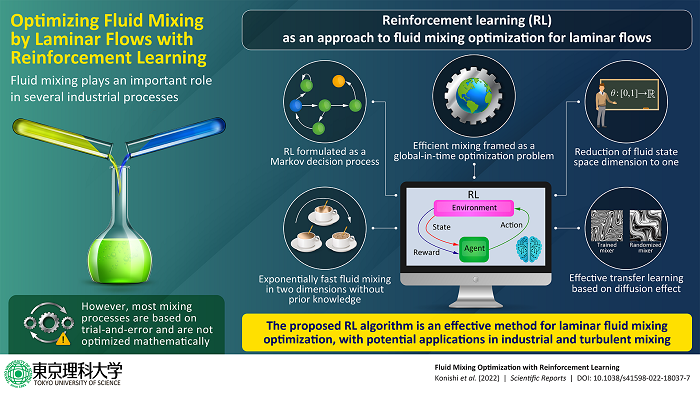Researchers from Japan adopt a reinforcement learning-based approach to study the process of fluid mixing during laminar flow
Fluid mixing is an important part of several industrial processes and chemical reactions. However, the process often relies on trial-and-error-based experiments instead of mathematical optimization. While turbulent mixing is effective, it cannot always be sustained and can damage the materials involved. To address this issue, researchers from Japan (Tokyo University of Science) have now proposed an optimization approach to fluid mixing for laminar flows using machine learning, which can be extended to turbulent mixing as well.
Mixing of fluids is a critical component in many industrial and chemical processes. Pharmaceutical mixing and chemical reactions, for instance, may require homogeneous fluid mixing. Achieving this mixing faster and with less energy would reduce the associated costs greatly. In reality, however, most mixing processes are not mathematically optimized and instead rely on trial-and-error-based empirical methods. Turbulent mixing, which uses turbulence to mix up fluids, is an option but is problematic as it is either difficult to sustain (such as in micro-mixers) or damages the materials being mixed (such as in bioreactors and food mixers).

Can an optimized mixing be achieved for laminar flows instead? To answer this question, a team of researchers from Japan, in a new study, turned to machine learning. In their study published in Scientific Reports, the team resorted to an approach called “reinforcement learning” (RL), in which intelligent agents take actions in an environment to maximize the cumulative reward (as opposed to an instantaneous reward).
“Since RL maximizes the cumulative reward, which is global-in-time, it can be expected to be suitable for tackling the problem of efficient fluid mixing, which is also a global-in-time optimization problem,” explains Associate Professor Masanobu Inubushi, the corresponding author of the study. “Personally, I have a conviction that it is important to find the right algorithm for the right problem rather than blindly apply a machine learning algorithm. Luckily, in this study, we managed to connect the two fields (fluid mixing and reinforcement learning) after considering their physical and mathematical characteristics.”
The work included contributions from Mr. Mikito Konishi, a graduate student, and Prof. Susumu Goto, both from Osaka University.
One major roadblock awaited the team, however. While RL is suitable for global optimization problems, it is not particularly well-suited for systems involving high-dimensional state spaces, i.e., systems requiring a large number of variables for their description. Unfortunately, fluid mixing was just such a system.
To address this issue, the team adopted an approach used in the formulation of another optimization problem, which enabled them to reduce the state space dimension for fluid flow to one. Put simply, the fluid motion could now be described using only a single parameter!
The RL algorithm is usually formulated in terms of a “Markov decision process” (MDP), a mathematical framework for decision making in situations where the outcomes are part random and part controlled by the decision maker. Using this approach, the team showed that RL was effective in optimizing fluid mixing.
“We tested our RL-based algorithm for the two-dimensional fluid mixing problem and found that the algorithm identified an effective flow control, which culminated in an exponentially fast mixing without any prior knowledge,” says Dr. Inubushi. “The mechanism underlying this efficient mixing was explained by looking at the flow around the fixed points from a dynamical system theory perspective.”
Another significant advantage of the RL method was an effective transfer learning (applying the knowledge gained to a different but related problem) of the trained “mixer.” In the context of fluid mixing, this implied that a mixer trained at a certain Péclet number (the ratio of the rate of advection to the rate of diffusion in the mixing process) could be used to solve a mixing problem at another Péclet number. This greatly reduced the time and cost of training the RL algorithm.
While these results are encouraging, Dr. Inubishi points out that this is still the first step. “There are still many issues to be solved, such as the method’s application to more realistic fluid mixing problems and improvement of RL algorithms and their implementation methods,” he remarks.
While it is certainly true that two-dimensional fluid mixing is not representative of the actual mixing problems in the real world, this study provides a useful starting point. Moreover, while it focuses on mixing in laminar flows, the method is extendable to turbulent mixing as well. It is, therefore, versatile and has potential for major applications across various industries employing fluid mixing.
Sign up for the free insideAI News newsletter.
Join us on Twitter: https://twitter.com/InsideBigData1
Join us on LinkedIn: https://www.linkedin.com/company/insidebigdata/
Join us on Facebook: https://www.facebook.com/insideAI NewsNOW





Speak Your Mind